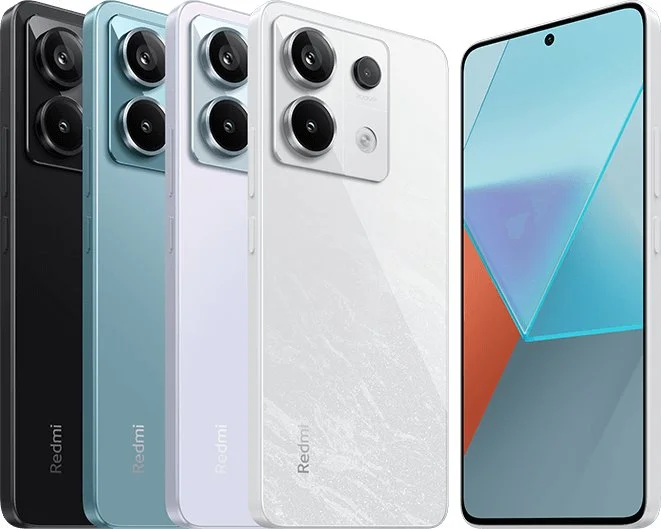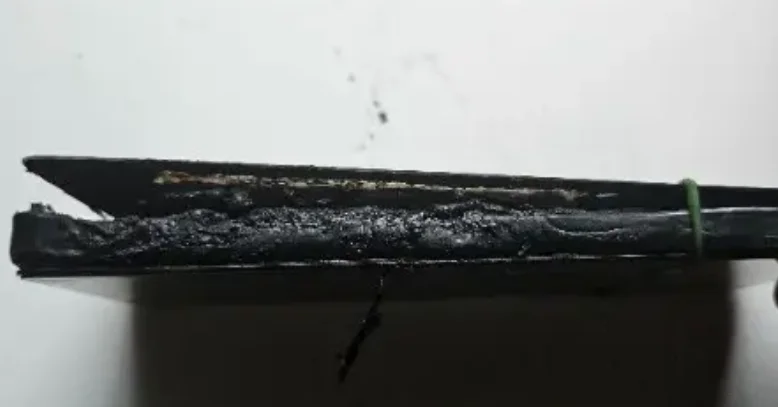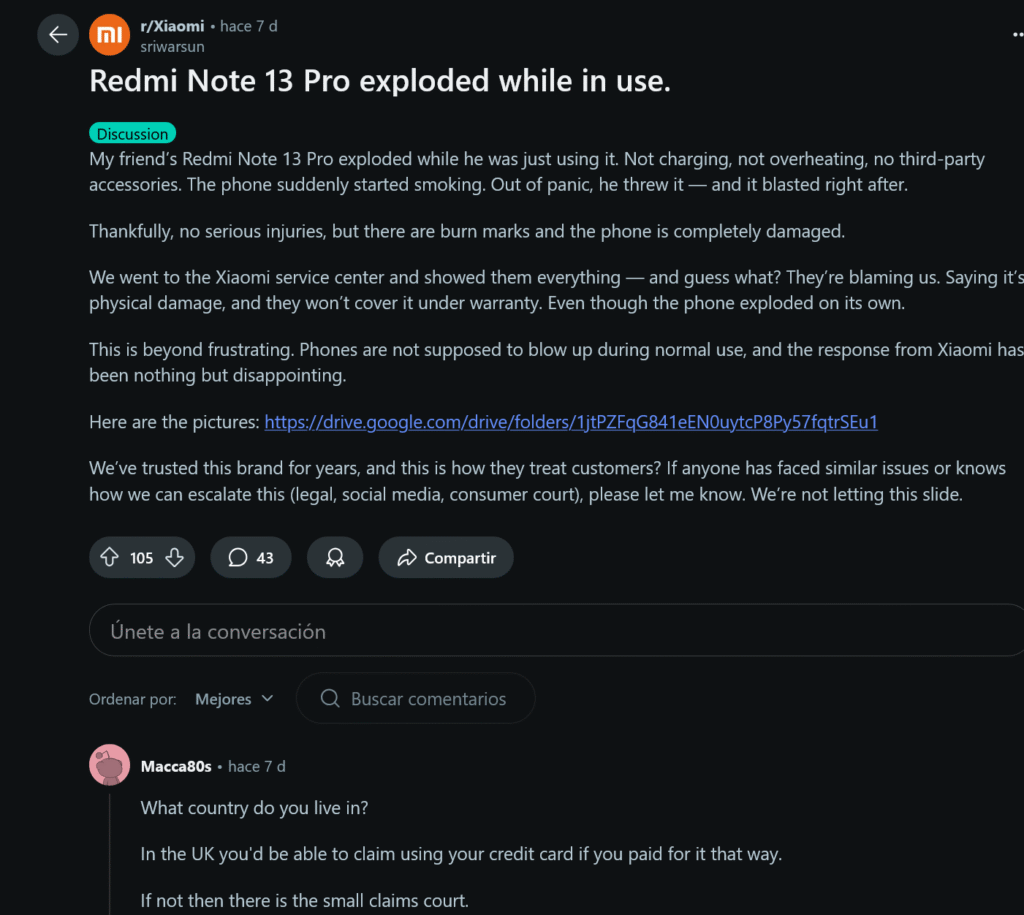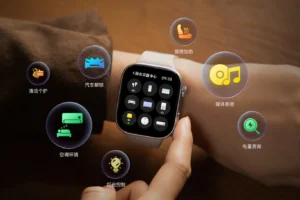Redmi Note 13 Pro Explodes: User Error or Xiaomi Fault?

Redmi Note 13 Pro Explodes in India: User Error or Manufacturer Fault?
A pretty scary incident has folks talking in the smartphone world after a Redmi Note 13 Pro 5G reportedly exploded during everyday use in India. According to a Reddit user named Sri Varshan, his friend’s phone suddenly started smoking, and within seconds, it blew up, leaving the device completely trashed. Thankfully, nobody got hurt, but this has definitely sparked a big debate about how safe our mobile gadgets really are and where the manufacturer’s responsibility lies.
The whole thing happened while the phone was just being used normally. It wasn’t even plugged into a charger, and there were no signs of it overheating beforehand. While Sri didn’t mention exactly what app was running at the time, he was pretty clear that it was just routine handling. After the incident, they took the phone to a Xiaomi service center, but Xiaomi refused to honor the warranty, claiming the damage was due to “user misuse.” This response understandably ticked Sri off, and he voiced his frustration, saying, “I’ve trusted Xiaomi for years, but this stance is unacceptable.” Now, he’s looking into legal options and plans to really push this case on social media.
The pictures Sri shared show the device with damage concentrated on the lower part, near the battery. This definitely points towards a potential issue with that specific component. There’s also a burnt rubber band found around the phone, which has some people wondering if external pressure might have played a role in what happened. Tech experts who’ve weighed in with international media mention that the lithium-ion batteries found in most smartphones can become unstable if they get damaged, exposed to high temperatures, or, you know, have manufacturing defects.
Now, it’s not exactly the first time a Xiaomi device, or even one from its sub-brand Poco, has faced similar accusations. Back in 2021, models like the Poco M3, Redmi Note 9 Pro, and Poco X3 were reportedly involved in around five explosion cases, according to reports compiled on X (formerly Twitter). These past incidents have really cranked up the criticism towards Xiaomi, putting them under pressure to step up their quality control and customer service game. As of now, the company hasn’t put out an official statement on this specific Redmi Note 13 Pro case, but users on X are demanding a transparent investigation.
Diving Deeper: What Actually Causes These Explosions?
We all rely on our phones for pretty much everything these days, so hearing about them exploding is, frankly, terrifying. It’s natural to wonder what goes wrong.
The Inner Workings of a Lithium-Ion Battery
Lithium-ion batteries are the go-to power source for our gadgets because they’re super efficient and pack a lot of juice into a small package. But here’s the thing: they’re also pretty sensitive. Think of them like tiny chemical powerhouses.

- Manufacturing Defects: Sometimes, things just don’t go perfectly on the factory floor. Even tiny imperfections in the way the battery is made – like a small piece of metal or a microscopic tear in the separator layer – can create internal shortcuts. These shortcuts can lead to a buildup of heat, which then triggers a runaway chemical reaction.
- Physical Damage: We’ve all dropped our phones, right? Even if it doesn’t look too bad on the outside, a significant drop or impact can damage the delicate internal structure of the battery. This damage can compromise the separator, allowing the anode and cathode to touch, leading to a short circuit and potential thermal runaway.
- Heat Exposure: Lithium-ion batteries really don’t like being too hot. Leaving your phone out in direct sunlight, in a hot car, or even using it heavily while it’s charging in a warm environment can push the battery’s temperature too high. Excessive heat can accelerate the chemical reactions inside the battery, leading to gas production and, in worst-case scenarios, an explosion.
- Charging Issues: While modern phones have advanced charging management systems, using uncertified or damaged chargers can still pose a risk. Chargers that don’t meet the device’s specifications might supply unstable voltage or current, which can stress the battery and, over time, degrade its performance and safety.
While these incidents are statistically quite rare considering the billions of smartphones in use worldwide, when they do happen, the consequences are significant and understandably grab a lot of attention.
How to Keep Your Xiaomi Phone (and Yourself!) Safe
It’s easy to feel a bit uneasy after hearing about incidents like this. But the good news is that most of the time, these battery issues are either due to a rare manufacturing defect or preventable user behavior. We can all do our part to keep our devices running smoothly and safely.

Here are some practical tips to minimize the risks associated with your smartphone battery:
- Stick to Original Chargers:
Seriously, this is a big one. Those cheap, off-brand chargers might seem like a bargain, but they often don’t have the same safety certifications or quality control as official Xiaomi chargers. Using a non-certified charger can lead to inconsistent charging voltages, overcharging, and ultimately damage your phone’s battery. Always try to use the charger that came with your phone or a reputable, certified replacement. - Avoid Extreme Heat:
Our phones are like us – they don’t do well in extreme heat. Keep your phone out of direct sunlight, especially on hot days. Never leave it on a dashboard in a car or in any enclosed space that gets really hot. If you’re using your phone for a demanding task like gaming or GPS navigation for an extended period, and it starts to feel warm, take a break. - Listen to Your Phone (and Its Battery):
If you notice your phone’s battery is swelling up, or the device itself is getting unusually hot during normal use, it’s a clear sign something’s not right. Don’t ignore it! Take it to an authorized Xiaomi service center immediately. They can diagnose the problem and advise on whether the battery needs to be replaced. Trying to “push through” or ignore these symptoms can be dangerous. - Be Mindful of Charging Habits:
While most modern smartphones have built-in protection against overcharging, it’s still a good idea to be aware of how you charge your device. Charging your phone overnight without supervision, especially if it’s on your bed or under pillows, can be risky. Overheating can occur if there’s a fault, and the lack of ventilation can trap that heat. If possible, charge your phone on a hard, cool surface. - Protect Your Investment with a Good Case:
A sturdy case isn’t just about looks; it can offer crucial protection against physical damage. A good case can absorb shock from accidental drops, potentially preventing internal battery damage that could lead to instability. Look for cases that offer good corner protection and a slight lip around the screen and camera.
By following these simple guidelines, you can significantly reduce the chances of encountering battery-related issues with your Xiaomi device.
A Look Back: Past Incidents and Concerns
As I mentioned earlier, this isn’t the first time Xiaomi or its sub-brand Poco has been in the spotlight for battery incidents. It’s important for us at xiaomiforall.com to provide a balanced view, acknowledging these past events as they shape customer perception and manufacturer response.

The reports from 2021 involving models like the Poco M3, Redmi Note 9 Pro, and Poco X3 highlighted a pattern of similar issues. Users took to social media and forums to share their experiences, often describing the phones unexpectedly swelling or catching fire. This led to a significant amount of negative publicity for the brand.
What These Incidents Mean for Xiaomi
When a brand faces multiple reports of device malfunctions, especially something as critical as battery explosions, it inevitably raises questions about their quality control processes. For Xiaomi, which aims to make technology accessible to a global audience, maintaining consumer trust is paramount.
- Quality Control:
These past incidents suggest a potential need for even more rigorous testing and quality assurance at every stage of production. This includes sourcing battery components, manufacturing processes, and final product checks. - Customer Service Response:
The way a company handles such incidents is crucial. Refusing warranty claims without thorough investigation, as alleged in this recent case, can severely damage customer loyalty. A more transparent and empathetic approach, coupled with a willingness to investigate and address genuine faults, is vital. - Market Perception:
For a brand that prides itself on offering great value, reliability is just as important as affordability. Repeated battery issues can unfortunately lead to a perception that Xiaomi devices might be less safe or durable, which can deter potential buyers.

It’s a tough balance for any manufacturer. They are producing millions of devices, and while defects are rare, they do happen across the industry. However, the key differentiator is how the company responds to these challenges.
The Redmi Note 13 Pro 5G: A Quick Spec Snapshot
To give you a bit of context on the device involved, here’s a look at some of its key specifications. While these specs don’t directly explain the explosion, they highlight the kind of technology we’re talking about.
| Feature | Redmi Note 13 Pro 5G |
|---|---|
| Display | 6.67-inch AMOLED, 120Hz refresh rate, HDR10+ |
| Processor | Qualcomm Snapdragon 7s Gen 2 |
| RAM | 8GB / 12GB |
| Storage | 128GB / 256GB / 512GB |
| Rear Camera | 200MP (wide) + 8MP (ultrawide) + 2MP (macro) |
| Front Camera | 16MP (wide) |
| Battery | 5100 mAh |
| Charging | 67W wired |
| Operating System | Android with MIUI (at launch) |
| Connectivity | 5G, Wi-Fi 6, Bluetooth 5.2, NFC |
The Redmi Note 13 Pro 5G is generally a well-regarded device, known for its strong camera capabilities and solid performance for its price point. The fact that it’s involved in such a serious incident is certainly concerning for owners and potential buyers.
What Happens Next?
The situation with Sri and his friend’s Redmi Note 13 Pro is still unfolding. Sri’s intention to pursue legal action and amplify the case on social media means this could become a much bigger story.
For Xiaomi, this is a critical moment. They have the opportunity to address the concerns directly and transparently. A detailed investigation into the specific device, an open communication with the affected user, and a clear explanation of their findings would go a long way in rebuilding trust.
The crux of the matter really boils down to accountability. Was this a rare manufacturing defect that slipped through quality control? Or was there indeed some form of user misuse, even if unintentional? Without a thorough investigation by an independent body or a very transparent one by Xiaomi itself, it’s hard to say for sure.
This incident serves as a stark reminder that even with advanced technology, safety must remain the absolute top priority for manufacturers. For us, as consumers, staying informed and taking responsible care of our devices is just as important.








2 thoughts on “Redmi Note 13 Pro Explodes: User Error or Xiaomi Fault?”